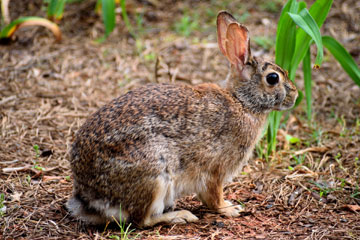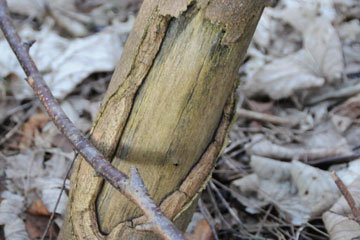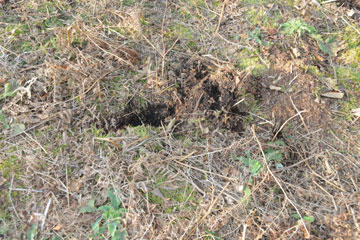The European Rabbit (Oryctolagus cuniculus)

Originally native to the Iberian Peninsula, the European rabbit has been widely introduced to many areas, often causing devastating effects on local biodiversity; the species was probably introduced into the UK by the Romans, around 2000 years ago. In 2005, the UK rabbit population was estimated at 37.5 million (JNCC/Tracking Mammals Partnership).
The rabbit is a small mammal, about 300-450mm in length, and weighing between 1-2.5kg. The rabbit is a lagomorph, related to hares and pikas, and has self-sharpening incisors (two on top, two on bottom) which grow continuously throughout the animal’s life. In addition, the rabbit, in common with all lagomorphs, has two peg teeth on the top behind the incisors, unlike rodents which simply have only two incisors, top and bottom, and no peg teeth.
Rabbits can mate as early as 3 months of age, with a gestation period of 31 days. The average litter size is 4 to 12; the young are born blind, naked and totally dependent on their mother (altricial), and known as kittens.

Rabbits are near-sighted with a blind spot directly in front of them, and crepuscular, i.e. most active in the early morning and in the late evening. Rabbits have large powerful hind legs, and move by hopping. To enable rapid hopping, the rabbit's hind feet have a thick padding of fur, which dampens the shock of rapid hopping. Their long toes are webbed, preventing them from spreading as the animal jumps.
Rabbits are gregarious, living in colonies in networks of burrows called warrens, where they spend most of their time when not feeding. The warrens are excavated primarily by the doe, usually during pregnancy, and she will dig short, blind tunnels as nesting stops, and does are probably also responsible for the excavation of most of the connecting tunnels. Grass is the rabbit’s primary food source, but they will also eat plants and crops, and even browse. Rabbits will gnaw trees, in particular young saplings; such damage can - and often does - kill the trees.

The rabbit’s sex life is complex, with dominant males being polygynous, i.e. males mate with several females, with lower-status individuals (both bucks and does) often forming monogamous breeding relationships. Parallel dominance hierarchies exist for both bucks and does, although dominant does are usually the mates of the dominant buck. Males show considerable investment in the welfare of the young, although much of this aspect of rabbit behaviour is poorly understood.
Rabbits can be extremely aggressive with competition between males often leading to severe injury and even death. Although hostile displays are used, and males often squirt urine on challengers as a form of territorial marking, the most common response to a challenge is immediate attack, using their powerful back legs as weapons, and also biting and scratching with the front paws.
Much of the modern research into wild rabbit behaviour was carried out in the 1960s by two research centres - the naturalist Ronald Lockley who maintained a number of large enclosures for wild rabbit colonies, with observation facilities, in Orielton in Pembrokeshire, and at the Commonwealth Scientific and Industrial Research Organisation (CSIRO) in Australia where Mykytowycz & Myers performed studies on the social behaviour of wild rabbits. Since the onset of myxomatosis and the decline of the significance of the rabbit as an agricultural pest, few large scale studies have been performed, and today many aspects of rabbit behaviour are still poorly understood.
Ronald Lockley’s book, "The Private Life of the Rabbit" is a must-read for anyone interested in conies, and was credited by Richard Adams as having played a key role in his gaining "a knowledge of rabbits and their ways" that was espoused in his novel "Watership Down".

